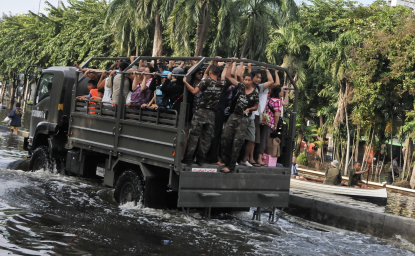To Protect Financial Stability, Confront Climate Change
Determined policy action can help meet an existential challenge.
Determined policy action can help meet an existential challenge.

Climate change confronts humanity with an existential challenge. Climate-related disasters already cause immense human suffering as well as large economic, financial, and ecological damages. Direct damages from Thailand’s 2011 floods, for example, cost around 10 percent of the country’s GDP. Over the past decade, direct damages of climate-related disasters added up to $1.3 trillion (or around 0.2 percent of world GDP on average per year). Indirect damages were even higher: although precise estimates currently do not exist, some have calculated that indirect costs may be five to ten times the direct costs, or $6.5–$13 trillion. For instance, the total estimated cost of California’s 2018 wildfires is about 11 percent of California’s GDP, versus only 1 percent for the direct damage. Moreover, climate science is sending us a clear warning: Unless we change our ineffective current policies, extreme weather events are destined to become more destructive and more frequent, and global warming will have increasingly disruptive socio-economic impacts.
Climate change puts global financial stability at risk. Destructive hurricanes and droughts not only increasingly chip away at the global economy, but they also weaken financial stability. Our recent Global Financial Stability Report examined the impact of climate change’s physical risk (the loss of life and property as well as disruptions to economic activity) on financial stability: it found that stock market investors are not paying enough attention to this risk, and they should.
The increasingly destructive impacts of hurricanes and wildfires illustrate that even seemingly well-known types of risks can take us by surprise. Addressing the climate challenge fundamentally requires that the global economy move away from a dependence on resources that produce high carbon dioxide emissions, like coal. To do so will require planning for a necessary and complex transition to a low-carbon economy. Firms with business models dependent on carbon emissions could see their earnings decline and their funding costs increase, while other industries may benefit from new opportunities. Global investments to address climate change are estimated in trillions of U.S. dollars, and most are likely to be intermediated through the financial system. Financial instability can materialize if—following a period of inaction—the low-carbon transition becomes uncoordinated or abrupt, triggering rapid shifts in investor and consumer behavior. If the financial system is weak, for example, due to excessive leverage, it will exacerbate these shocks, hurting the real economy.
Policymakers are starting to recognize the dramatic implications of climate change for financial stability, and the urgency of speeding the low-carbon transition. Incorporating climate-related risks into policymaking requires assessing financial stability over longer horizons, using new methodologies. A growing number of central banks and financial regulators—including those in the Network for the Greening of the Financial System (NGFS)—are realizing the importance of these issues and are aiming to integrate climate-related risks into financial stability oversight.
The International Monetary Fund (IMF) is helping countries better understand the macro-financial transmission of climate risks. Analyzing risks and vulnerabilities is at the core of what we do at the Fund. The IMF pioneered the use of stress test for financial stability analysis 20 years ago when, along with the World Bank, it began the Financial Sector Assessment Program (FSAP). Over the past decade, one in five FSAP assessments considered climate-related risks, and IMF staff have been working to increase coverage of those risks in ongoing and planned FSAPs. Earlier tests focused on physical risks, such as insurance losses and nonperforming loans associated with natural disasters. Recently, our stress tests—such as the 2019 assessment for the Bahamas—have included scenarios that analyze the combined macro-financial impact of a severe hurricane and an economic downturn. More comprehensive assessments are planned in other countries, and IMF staff have started examining the financial system’s exposures to the low-carbon transition. Next steps include capturing second-round effects, in which asset price declines lead to “fire sales,” generating vicious cycles that amplify the initial shock. IMF staff collaborate with World Bank colleagues, NGFS members, and others to further upgrade the framework for assessing climate-related risks.
Only with accurate and standardized reporting of climate risks in financial statements can investors discern companies’ exposures to climate-related risks. The Fund supports efforts to strengthen the quality and consistency of climate disclosures. Efforts such as those of the Task Force on Climate-related Financial Disclosures are welcome, but IMF research has found disclosures to be uneven across countries and asset classes. Partly as a result, investors have been reluctant to invest at the scale necessary to mitigate climate change, especially since policy action to address climate change has been lagging.
The standardization of climate risk disclosures would improve the comparability of information in financial statements across markets and jurisdictions. Granular, firm-specific information on exposures and vulnerabilities would help lenders, insurers, and investors to better grasp climate risk. It would also help improve climate stress testing by central banks, supervisors, and other oversight bodies. Developing a global climate risk disclosure framework requires stepping up global cooperation and global leadership. Such a framework is essential for preserving financial stability.

More broadly, the IMF can help by providing advice to policymakers on climate-related macro-financial policies. Addressing climate change in a sustainable way requires strong global policy action across many policy fronts. Macro-financial policies have a key role to play due to the magnitude and global nature of the risks and the strong complementarities of climate protection with macroeconomic performance and financial stability. For example, expanding the availability of insurance and increasing the sovereign’s financial strength can reduce the impact of climatic disasters, thus decreasing financial stability risks. Fiscal policies (such as carbon pricing) and structural policies (such as emission standards) have key roles to play in reducing emissions and mobilizing revenues, but the financial sector is also critical. Financial institutions and markets already provide financial protection through insurance and other risk-sharing mechanisms, such as catastrophe bonds. The financial system can help mobilize resources for investments in climate mitigation (reducing emissions) and adaptation (building resilience) in response to price signals such as carbon prices. If policymakers implement policies to price externalities and to incentivize the low-carbon transition, the financial system can help achieve these goals efficiently. The IMF has thus been integrating climate change into its financial sector policy advice.
The COVID-19 pandemic reminds us that crisis preparedness and resilience are essential to manage risks from uncertain, complex events that can have extreme economic and human costs. The pandemic highlights the fragility of our natural world, underscoring the fact that climate change remains an urgent and existential issue. Like the pandemic, the climate crisis may seem remote, but its impact can manifest itself abruptly. Like the pandemic, the climate crisis is linked to the degradation of the natural environment. Like the pandemic, poor and vulnerable populations suffer most from climate shocks. Like the pandemic, ignoring the climate crisis involves massive financial risks. Like the pandemic, the climate crisis has no borders, and mitigation is less costly than containing the crisis once it has materialized. And like the pandemic, the climate crisis requires a forceful and globally coordinated response.
The pandemic-induced economic crisis does not change the fundamental climate challenge, or the proper response to it. Even a prolonged global recession would have only a modest impact on the stock of atmospheric greenhouse gas emissions. Therefore, raising the cost of emissions remains central to addressing the externality problem at the heart of climate change. And the policy action required also remains ambitious: For example, containing global warming to 2°C or less would require rapidly phasing in measures equivalent to a global tax of at least $75 per ton by 2030, whereas the current global average carbon price is $2 per ton.
Taking action to address climate change demands the mobilization of both public and private finance. In that context, it is critical to ensure that financial instability does not undermine the low-carbon transition. Financial firms and infrastructures, central banks, and financial regulators have essential roles to play: with determined action, the financial community can help society increase its chances of survival as it confronts the looming climate crisis.

The Environmental Change and Security Program (ECSP) explores the connections between environmental change, health, and population dynamics and their links to conflict, human insecurity, and foreign policy. Read more




